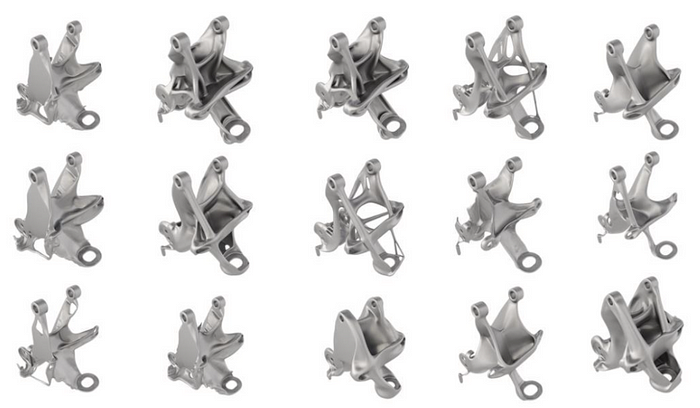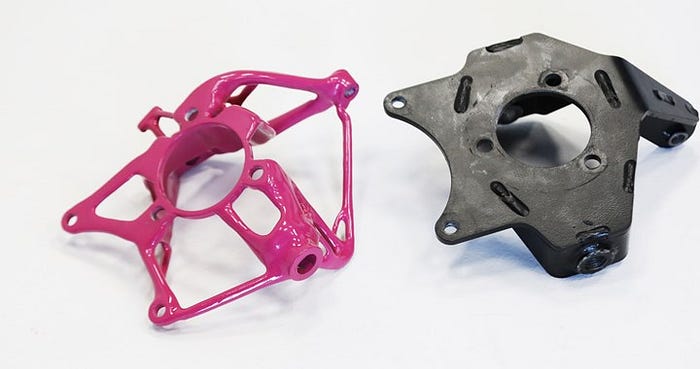Generative Design: Disruption, Hype, or Threat?
What happens when AI design physical parts

Defining generative design is a tough task. For starters, there is no consensus in the industry or academia of what the term actually means. Oftentimes it is used as an umbrella term for algorithm-based design techniques when it’s in fact an AI-driven method of its own.
My experience with generative design is limited to one offered by Autodesk through Fusion 360, so this discussion will be centered around the context of mechanical engineering design. It might also be worth noting that all the thoughts and insights in here are simply my own impressions of this technology as a curious engineer and a maker myself.
So, with that out of the way, we can start by how I would describe generative design.
AI meets design
Generative design (GD) is a computational tool that leverages artificial intelligence (AI) and cloud computing to generate multiple design solutions based on user-defined constraints and objectives. Not the most useful definition, I agree, so let’s take a couple of minutes to better understand its concept.

Say we need to design a chair for a given application. Before we even start sketching on a napkin, we must first understand the requirements for the chair and define some technical specifications: what’s its overall size? How much weight can it stand and how heavy can it be ? Does it need armrests? Which materials can be used? How will it be produced and how much will it cost?
A traditional design process is built upon such specifications, defined in the very early stages of product development. From there, the development team can start working on different conceptual ideas for the product itself.
The same goes for a generative design process, but these constraints and objectives are instead fed directly onto software that will come up with multiple chair designs that fit all the requirements simultaneously, even commercial ones like manufacturing cost.
The most promising designs generated by the software are selected by the development team, which continues to work on them knowing that they meet the project requirements already. This is a major paradigm shift.

In a regular development process, a part has to be at least roughly designed prior to being tested with computer simulations. With generative design, however, the parts and components are designed through these simulations.
Besides the obvious gains in productivity and costs, perhaps the main benefit of this technology is that AI doesn’t think like us. Computer algorithms don’t know how a chair is supposed to look like in the first place, so it is free to create whatever respect constraints and objectives — and this is gold.
We instantly note that simply by looking at generative designed parts. The odd-looking designs feel organic, almost alive. And in a way, they are.
Evolutionary computation
Generative design algorithms come up with design solutions through iteration: they start with the most basic and unoptimized forms and run several simulations to examine how they would behave in real-life working conditions.
Each tiny infinitesimal piece of the starting design is analyzed regarding its performance towards the whole part. For instance, in structural analysis, the regions that don’t contribute mechanically towards the part’s rigidity or resistance can be removed without penalties to the overall performance. Inversely, the weaker regions identified through the simulations can be reinforced until in a safe range of stress.

This process is repeated until both the constraints and objectives converge, and no further optimization is possible. For our chair example, we would get all possible chair solutions that fit the requirements (size, strength, material) while also meeting the objectives (costs, weight, manufacturability).
I like to think of generative design as a ‘mini’ evolutionary process that happens in the cloud. In nature, accidental biological changes were rewarded by natural selection mechanisms over millions of years, and these small incremental changes eventually led to the creation of incredibly complex and adapted structures like the human body.
All things considered, a few parallels can be traced between these two processes. The evolution theory is based on some principles: variation in populations, inheritance, competition, survival of the fittest, among others.
A generative process begins with different starting designs (variation), and each undergoes incremental changes that are carried throughout the process (inheritance) and strives to become the most efficient and adapted for that given condition (the fittest). By the end of the process, we could even that say all resulting designs compete among themselves for being selected.
Why it isn’t a thing (yet)
Generative design algorithms have been around since the 1990s, but apart from a few really cool projects, it hasn’t really shined yet. So why now?
Similar to other AI applications, the lack of proper computer processing power and cloud computing posed major obstacles to generative design. Only within the past decade these technologies began ripening, and that’s exactly when other algorithmic design tools like topology optimization start becoming relevant.

On the other hand, what good is to design something amazing if one cannot produce it in an economically viable manner? This is where additive manufacturing technologies enter. These production techniques are slowly but surely reaching maturity for industrial-scale manufacturing, and perhaps that’s when the full potential of generative design can be exploited.
Finally, implementation is often a challenge to potentially disruptive technologies. Generative design is far from being a turn-key solution, and besides the computational infrastructure and steep learning curve, it has the potential to shift paradigms in a way that entire design processes would need re-think. This by itself already takes a lot of time, energy, and money.
The recent renewed interest in space exploration might just be the push that this technology needed. High-tech companies often rely on yet-to-be-proven technologies to be able to reach further, and the time finally seems right to generative design.
Man vs machine
The question always arises when new automation tools emerge: wouldn’t generative design ultimately replace humans entirely in the “designing stuff” business?
A friend of mine used to say that, for engineering simulations, “garbage in, garbage out”. It turns out the expression was borrowed from computer science, but the principle remains: if the inputs are inaccurate, the results will be just as inaccurate — regardless of the tool.

So, in the end, algorithmic design will always demand a skilled team of engineers to drive it. Besides, generative design is not a tool for all trades: the required amount of setup time and processing power to run it must be justified.
Ultimately, the way it is set up today, generative design just can’t replace humans. But it could be a useful ally, perhaps even in reducing our impact on the environment.
Back to nature
In engineering, we are often trying to make more with less. Usually, that’s only for beating your competitor’s price, but right now we must think about the environmental impact of whatever we are going to design.
At its core, generative designed parts are optimized through weight reduction, having implications that go beyond performance or cost. Lightweight parts require fewer resources to be produced and also less energy to be moved.
Lighter vehicles are naturally more efficient as they consume less fuel. To put in numbers, a single lightweight Airbus A320 part designed by generative processes was estimated to reduce aircraft carbon emissions by 465,000 tons annually, which according to the company, would be equivalent to removing 96,000 cars off the road for an entire year.

The verdict
Generative design shows great promise. Besides all the cost benefits and potential environmental gains, it could very possibly change the way we create things entirely.
By expanding the possibilities to unthinkable designs, GD could possibly inspire innovation by opening up our minds to new ideas while creating better products in the process.
Instead of trying to label it disruptive, hyped, or enemy, we should all see generative design as it is: a game-changing technology.
